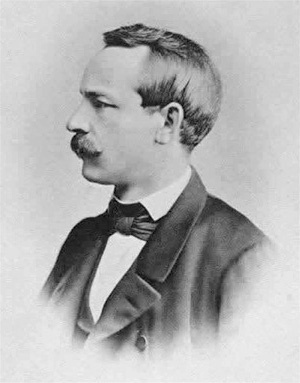Elwin Bruno Christoffel facts for kids
Quick facts for kids
Elwin Bruno Christoffel
|
|
|---|---|
 |
|
| Born | 10 November 1829 Montjoie, Prussia
|
| Died | 15 March 1900 (aged 70) |
| Nationality | German |
| Alma mater | University of Berlin |
| Known for | Christoffel symbols Christoffel equation Christoffel–Darboux formula Riemann–Christoffel tensor Schwarz–Christoffel mapping |
| Scientific career | |
| Fields | Mathematics Physics |
| Institutions | University of Strasbourg |
| Doctoral advisors | Martin Ohm Ernst Kummer Heinrich Gustav Magnus |
| Doctoral students | Rikitaro Fujisawa Ludwig Maurer Paul Epstein |
| Influences | Gustav Dirichlet Bernhard Riemann |
| Influenced | Gregorio Ricci-Curbastro Tullio Levi-Civita |
Elwin Bruno Christoffel (born November 10, 1829 – died March 15, 1900) was an important German mathematician and physicist. He came up with key ideas in a field called differential geometry. This work helped create tensor calculus, which later became the mathematical basis for general relativity, Albert Einstein's famous theory.
Contents
Life of Elwin Bruno Christoffel
Christoffel was born on November 10, 1829, in Montjoie (now Monschau) in Prussia. His family were cloth merchants. He first learned languages and math at home. Later, he went to schools in Cologne.
In 1850, Christoffel started studying at the University of Berlin. There, he studied mathematics with famous teachers like Gustav Dirichlet. He also took classes in physics and chemistry. In 1856, he earned his doctorate degree in Berlin. His research was about how electricity moves through certain materials.
After getting his doctorate, Christoffel went back to Montjoie. He spent three years there, away from other scientists. But he kept studying mathematics, especially how math applies to physics. He read books by important mathematicians like Bernhard Riemann. He also published two papers on differential geometry.
In 1859, Christoffel returned to Berlin. He became a "Privatdozent," which meant he could teach at the University of Berlin. In 1862, he became a professor at the Polytechnic School in Zürich. He helped set up a new math department there, which became very well-known.
Christoffel continued his research and published many papers. In 1868, he became a member of important science groups in Prussia and Italy. In 1869, he moved back to Berlin to teach at the Gewerbeakademie. However, this school struggled to attract enough students for advanced math classes. So, Christoffel left Berlin again after three years.
In 1872, Christoffel became a professor at the University of Strasbourg. This old university was being rebuilt into a modern one. Christoffel, along with his colleague Theodor Reye, built a strong mathematics department in Strasbourg. He taught many students, including those working on their doctorate degrees.
Christoffel retired from the University of Strasbourg in 1894. Even after retiring, he kept working and publishing his research. His last paper was finished just before he died and was published after his death.
Christoffel died on March 15, 1900, in Strasbourg. He never married and had no children.
Christoffel's Important Work
Christoffel is best known for his big contributions to differential geometry. This is a branch of mathematics that studies curves, surfaces, and shapes.
Understanding Curvature
In a famous paper from 1869, Christoffel introduced a key idea called covariant differentiation. He used this to define the Riemann curvature tensor. This tensor is a mathematical tool that helps describe the curvature of spaces. Think of it like describing how much a surface bends or curves at different points.
In the same paper, he also introduced the Christoffel symbols  and
and  . These symbols help explain how things change when you move around on a curved surface.
. These symbols help explain how things change when you move around on a curved surface.
Developing Tensor Calculus
Christoffel's ideas were later expanded by other mathematicians, Gregorio Ricci-Curbastro and Tullio Levi-Civita. They developed these ideas into the concept of tensors and what they called "absolute differential calculus." This "absolute differential calculus" was later named tensor calculus. Tensor calculus became the main mathematical tool used in general theory of relativity, which is Albert Einstein's theory about gravity.
See also
 In Spanish: Elwin Bruno Christoffel para niños
In Spanish: Elwin Bruno Christoffel para niños

